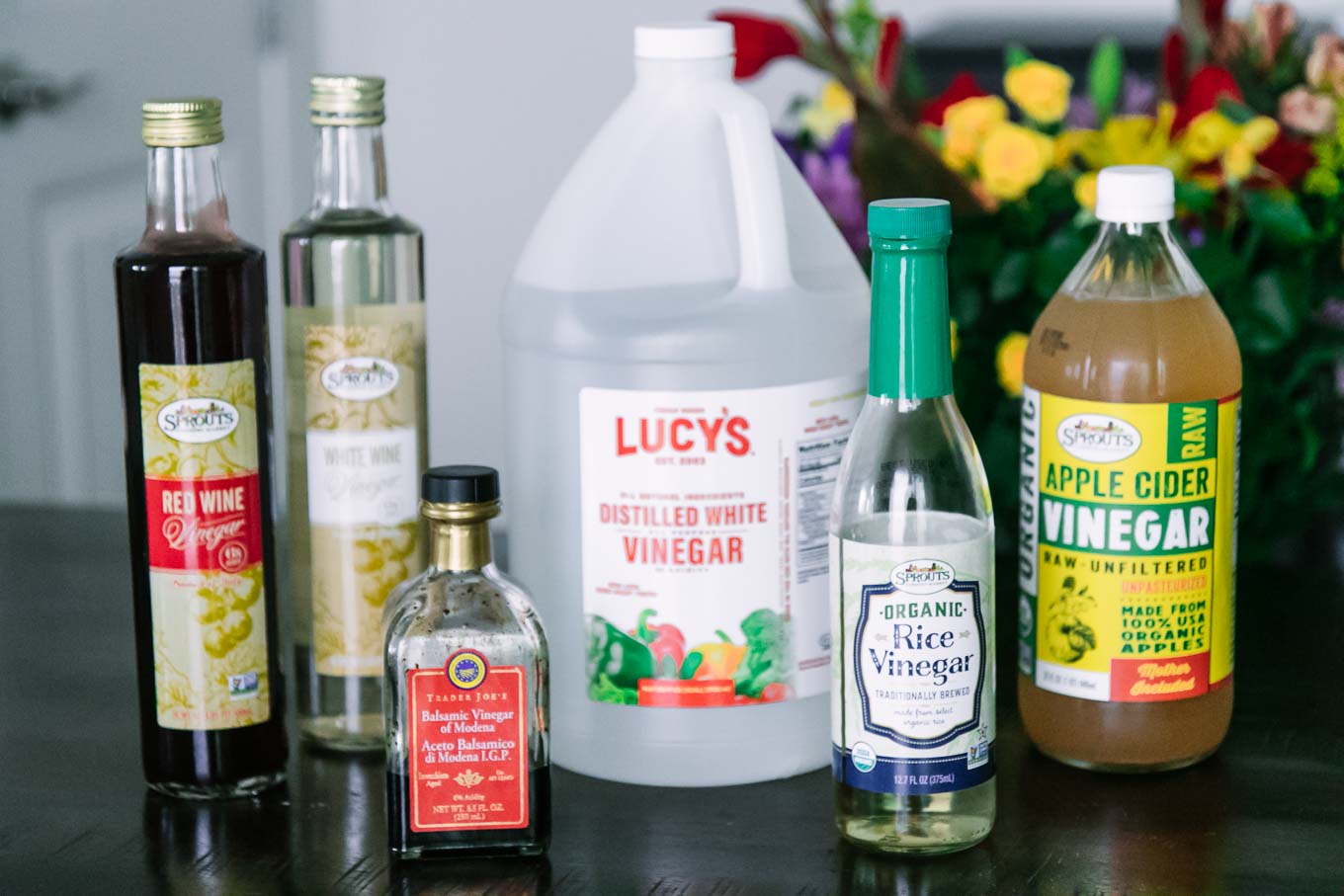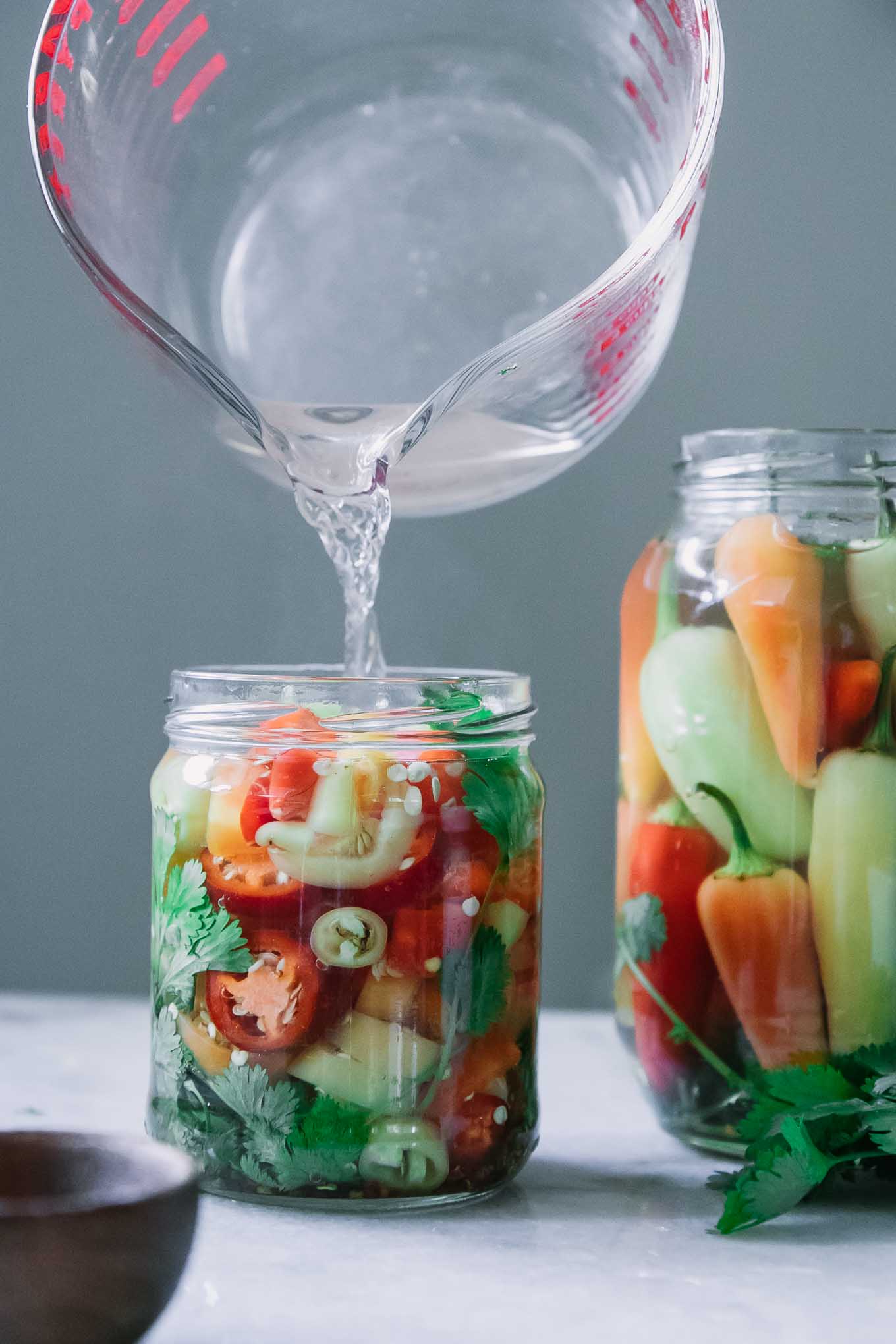Refrigerator Pickling Brine for Vegetables
Try this simple Refrigerator Pickling Brine for Vegetables, our go-to brine made with water, vinegar, salt, and sugar for refrigerator pickled veggies. Easy and tasty!

Want to Save This Recipe?
Enter your email & I’ll send it to your inbox. Plus, get new plant-based recipes in your inbox!
By submitting this form, you consent to receive emails from Fork in the Road.
Love pickling vegetrables? So do we! Try our go-to quick pickling brine that can be used as the foundational pickling brine for any vegetable. Super easy and ready in under 10 minutes.
👉 Ready to learn how to make a homemade brine for pickling vegetables? Let’s do it!
🧂Ingredients
- Water: regular tap water or filtered water work best
- Vinegar: most any vinegar will do for quick pickling, but we like white vinegar or white wine for most vegetables (see our vinegar recommendations section below)
- Salt: kosher salt is best, but any salt will do
- Sugar: granulate white or even brown sugar will work
- Additional flavorings: fresh herbs like dill or thyme, mustard (stone ground or seeds), garlic cloves, red pepper flakes

How to make (step-by-step photos)
1️⃣ Step One: Prepare and add the pickling brine
We increase or decrease the amount of brine depending on the amount of vegetables we’re pickling, but this is the foundational recipe we use that always produces great tasting pickled vegetables.
Our go-to refrigerator pickling brine formula is usually:
- 2 cups water
- 1 cup vinegar
- 1 tablespoon salt
- 1 tablespoon sugar (granulated white or brown)

To make the brine:
- Add water, a vinegar of your choice (see our tips for vinegar below), salt, and sugar to a medium saucepan and bring to a boil.
- Reduce to a simmer and continue to cook until the salt and sugar has dissolved.

2️⃣ Step Two: Pour over vegetables in a jar
After the sugar and salt has dissolved in the brine, pour the hot brine into a pickling jar and completely cover the vegetables.
Then close the lid tightly and allow it to cool down on the counter until it reaches room temperature.

3️⃣ Step Three: Refrigerate onion pickling jar
Once the jar is cool, put the jar into the refrigerator and allow the onions to pickle in the vinegar brine for at least two house, but for best flavor pickle them for at least 48 hours.

🥒 How long do pickled vegetables last in the refrigerator?
Refrigerator pickled vegetables are good up to two weeks in the refrigerator as long as they are submerged in the vinegar water.

👉 The best vinegar for quick pickling vegetables
With traditional canning and pickling, you want to choose a vinegar that is at least 5% vinegar for food safety reasons to avoid harmful bacterial growth.
However, quick pickling — or refrigerator pickling — is not the same as true canning and pickling as it only soaks the vegetables in a vinegar-based brine for flavor, and doesn’t truly pickle the vegetables. So any vinegar will work because you’re only storing the vegetables for under two weeks.
The best vinegar for quick pickling vegetables is whichever vinegar has the best flavor! Here are some of our favorites:
- White distilled vinegar: The plainest vinegar in taste, white vinegar is the foundational vinegar that can be used with any vegetable. It is light in taste and goes well with brines that include many other additional flavorings like herbs, mustard, and spices.
- White wine vinegar: Another light vinegar, but has a distinct wine flavor. Best for light vegetables like onions, shallots, zucchini, etc.
- Red wine vinegar: A very particular tasting vinegar and pairs better with sturdier vegetables. Great with red onions, tomatoes, and mushrooms.
- Apple cider vinegar: Very strong apple flavor, apple cider vinegar goes best with very hardy vegetables like carrots, parsnips, brussels sprouts or even with fruit like apples and pears.
- Rice vinegar: Very light in flavor, rice vinegar is usually used in Asian-inspired pickling recipes like scallions and daikon radishes. However, it’s a great flavor choice for most any vegetable.

❓ Questions and quick tips
Traditional pickling requires 5% vinegar for food safety reasons to prevent bacterial growth, but refrigerator pickling does not so you can enjoy any vinegar when quick picking vegetables. Our favorites include white vinegar, white wine vinegar, red wine vinegar, apple cider vinegar, and rice vinegar.
Most pickling brines call for a 1:1 ratio of water and vinegar, but for quick pickling vegetables we like a 2 part water and 1 part vinegar brine for a lighter flavor. However, play with the ratios and see what flavor you like best.
Most traditional pickling brines call for 1 to 2 tablespoons each of salt and sugar. We chose a lighter brine with 1 tablespoon of both sugar and salt, but you can add more to your personal tastes.

🧅 Recipes using quick pickling brine
We love quick pickling vegetables here at Fork in the Road! Here are a few of our favorites:

NOT SURE WHERE TO START WITH PLANT-BASED EATING?
Get my 4-Day Plant-Based Meal Plan to start your journey on the plant path.

Refrigerator Pickling Brine for Vegetables
Ingredients
- 2 cups water
- 1 cups vinegar see notes
- 1 tablespoon salt
- 1 tablespoon sugar
- Optional flavorings: vegetables of choice, garlic clove, mustard (seeds or dijon), fresh herbs (dill, etc.), red pepper flakes
Instructions
- Prepare brine: In a medium saucepan bring the water, vinegar, salt, and sugar to a boil. Once boiling, pour into a jar with vegetables and any desired optional ingredients (garlic, mustard, herbs, red pepper) until the liquid completely submerges them. Let the jar cool on the counter until it reaches room temperature.
- Pickling instructions: Once cooled, close the lid on the jar securely and put the jar into the refrigerator and let the vegetables pickle for at least 2 hours before serving, but for best results serve after at least 24 hours. Quick pickled vegetables are good up to two weeks in the refrigerator.
Notes
- Vinegar: White vinegar, white wine vinegar, apple cider vinegar, red wine vinegar, etc. will work, depending on the vegetable used
- Recommended jar: Choose a large and wide jar with about 1/2 – 1 inch space (2-3 cm) below the lid.
- Other recommended tools: small saucepan, cutting board, knife set
- Prep ahead and storage: Pickling brine is best when hot and fresh, so do not prep ahead.
- Nutrition notes: Nutrition information is calculated with all brine ingredients (including full amount of sugar, salt, etc.), however when you pickled vegetables they won’t absorb as much sugar and salt as you put into the brine so the actual nutrition information is less than listed here.

